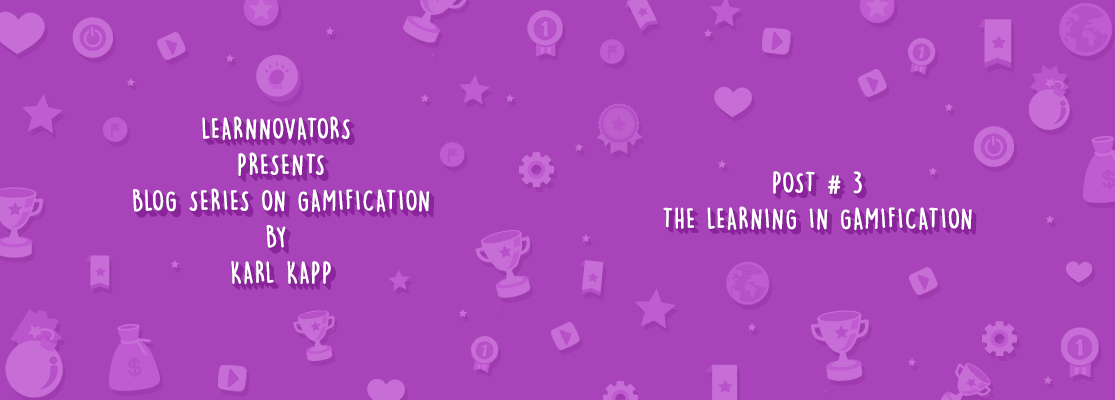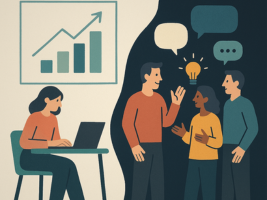THE LEARNING IN GAMIFICATION
This is the third in a series of articles about gamification written by Karl Kapp exclusively for Learnnovators. The first post in the series, GAMIFICATION FOR CORPORATE LEARNING, provided a definition of gamification, and further explained its two types. The second post, AVOID THESE GAMIFICATION PITFALLS, discussed the common pitfalls of gamification and how an organization can avoid them. This post covers the elements of gamification that can make learning effective. The series then proceeds to cover the the engagement aspects of gamification. The series closes by discussing the big miss and the big opportunity in gamification.
Gamification can be effective for learning, but what are the elements that make gamification effective? Here are four elements that contribute to learning through gamification.
1) RETRIEVAL PRACTICE – Retrieval practice is the technique of requiring a learner to answer a quiz question about a topic. In retrieval practice, the learner is asked to recall information rather than simply re-read or re-listen to it. A review of scientific literature reveals that the benefits of retrieval practice have been known for at least 100 years and the results have been demonstrated with many diverse groups. Retrieval practice alone can provide improved recall performance by as much as 10-20% (Dobson, 2013). Look for gamification platforms that ask the learner to recall content and act on that recall—having a system asking questions about content is a great way to have retrieval practice for learners.
2) SPACED RETRIEVAL – Spaced Retrieval involves providing learners with a quiz or course content spaced over time, delivered most often through a mobile device. This too is among the most robust findings in educational psychology research. It turns out that the greater the amount of spacing between retrieval events (24 hours is optimal), the greater the potential benefit to retention (Carpenter & DeLosh, 2005). Spaced retrieval helps learners retain access to memorized information over long periods of time because the spacing promotes deeper processing of the learned material. Spaced retrieval avoids two inherent problems with mass practice (learning all the information at once); the problems of learner fatigue, and the likelihood of interference preceding and succeeding learning.
3) HEIGHTENED ATTENTION LEVEL – Research on the neuroscience of memory has consistently shown that the process of storing new memories can be significantly enhanced by increasing physiological arousal (e.g., vigilance and stress) (Hamann, 2001; Cahill & McGaugh, 1998). In simpler terms, it is possible that engaging in a gamified learning situation stimulates learners, improving their vigilance and focus for the subsequent learning material.
4) CHALLENGE – Challenge is a strong motivator in learning (Malone, 1981; Schlechty, 1997; Jones et al., 1994). A challenge is a call to engage in a difficult, but achievable task. Uncertain outcomes are challenging because of the variability resultant from the learner’s actions, multiple goals, hidden information, and randomness (Wilson et al., 2009). Challenge is correlated with both intrinsic motivation and motivation related to fostering competence and learner efficacy (White, 1959). Challenges should be used in gamification to initially engage learners to start learning a task. Often learners who are reluctant to learn content can be persuaded to begin the process by being challenged through the goals they are to achieve in the gamified context.
REFERENCES
Cahill, L., & McGaugh, J. L. (1998). Mechanisms of emotional arousal and lasting declarative memory. Trends in neurosciences, 21(7), 294-299.Bourne, L. E., Dominowski, R. L., Loftus, E. F. & Healy, A. F. (1979) Cognitive Processes 2nd Edition. Englewood Cliffs, NJ: Prentice-Hall.
Carpenter S. K., & DeLosh, E. L. (2005). Application of the testing and spacing effects to name learning. Applied Cognitive Psychology, 19, 619–636.
Dobson, J. L. (2013) Retrieval practice is an efficient method of enhancing the retention of anatomy and physiology information Advances in Physiology Education 37: 184–191, 2013; doi:10.1152/advan.00174.2012
Hamann, S. (2001). Cognitive and neural mechanisms of emotional memory. Trends in cognitive sciences, 5(9), 394-400.
Jones, B., Valdez, G., Norakowski, J., & Rasmussen, C. (1994). Designing learning and technology for educational reform. North Central Regional Educational Laboratory. Retrieved from http://www.ncrtec.org/capacity/profile/profwww.htm.
Malone, T. (1981). Toward a theory of intrinsically motivating instruction. Cognitive Science, 4, 333-369.
Schlechty, P. C. (1997). Inventing better schools: An action plan for educational reform. San Francisco, CA: Jossey-Bass.
White, R. W. (1959). Motivation reconsidered: The concept of competence. Psychological Review, 66, 297-333.
Wilson, K. A., Bedwell, W. L., Lazzara, E. H., Salas, E., Burke, C. S., Estock, J., … Conkey, C. (2009). Relationships between game attributes and learning outcomes: Review and research proposals. Simulation & Gaming, 40, 217-266.Here are links to all five posts from this series:
1. Gamification For Corporate Learning
2. Avoid These Gamification Pitfalls
3. The Learning In Gamification
4. Gamification Is About Engagement
5. The Big Miss And The Big Opportunity In Gamification
.
Written by Karl Kapp
_________________________________
Published on 14-Sep-2016






